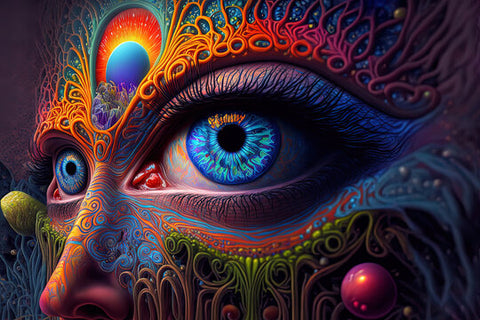A Deep Dive into N,N-Dimethyltryptamine
In the vast realm of psychedelic substances, DMT, or N,N-Dimethyltryptamine, stands out as one of the most potent and intriguing. This naturally occurring compound, found in various plants and animals, has been the subject of both ancient rituals and modern scientific research. In this article, we'll explore the multifaceted world of DMT, its traditional uses, effects, and its potential implications for modern medicine and spirituality.
1. What is DMT? Understanding the Basics
- Chemical Roots: DMT belongs to the tryptamine class of molecules, sharing its lineage with other renowned psychedelics like psilocybin and LSD.
- Natural Presence: From the bark of the Virola tree to the Psychotria viridis shrub, DMT's presence is widespread in nature. There's also speculation about its production in the human brain, particularly in the pineal gland.
2. DMT in Traditional Cultures
The Amazon rainforest, with its rich biodiversity, has been a treasure trove for indigenous tribes. For centuries, they've harnessed the power of DMT through a sacred brew called ayahuasca. By combining DMT-rich plants with MAO inhibitors, these tribes have been able to experience the profound effects of this compound, using it for spiritual and healing rituals.
3. The DMT Experience: A Journey Beyond the Known
DMT is often dubbed the "spirit molecule" for a reason. Those who venture into its realm report:
- Vivid Hallucinations: Users describe entering other dimensions, meeting otherworldly entities, and witnessing intricate geometric patterns.
- Altered Time Perception: Though the actual trip lasts between 5 to 30 minutes when smoked or vaporized, many feel as if they've been away for hours or even days.
- Emotional and Mystical Insights: Many users report profound realizations, feelings of interconnectedness, and even encounters with the divine.
4. Legality and Safety Concerns
As with many substances of its kind, DMT is classified as a Schedule I controlled substance in the U.S. and is illegal in numerous countries. While it has a relatively low toxicity profile, the psychological intensity of a DMT trip warrants caution. It's essential to be informed and safe if one chooses to explore this substance.

5. DMT in Modern Research
The 21st century has seen a renaissance in psychedelic research. Scientists are now probing DMT's potential therapeutic benefits. Preliminary studies suggest potential in treating conditions like depression, anxiety, and PTSD. However, comprehensive research is still in its infancy, and much remains to be discovered.
Conclusion
DMT, with its rich history and profound effects, continues to intrigue and mystify. As science delves deeper into its potential benefits and the global community becomes more open to the world of psychedelics, DMT might just find its place not just in ancient rituals but in future therapeutic practices.
Note: This article is for informational purposes only and does not endorse or promote the use of illegal substances. Always consult with a professional before making any decisions related to health or legal matters.

